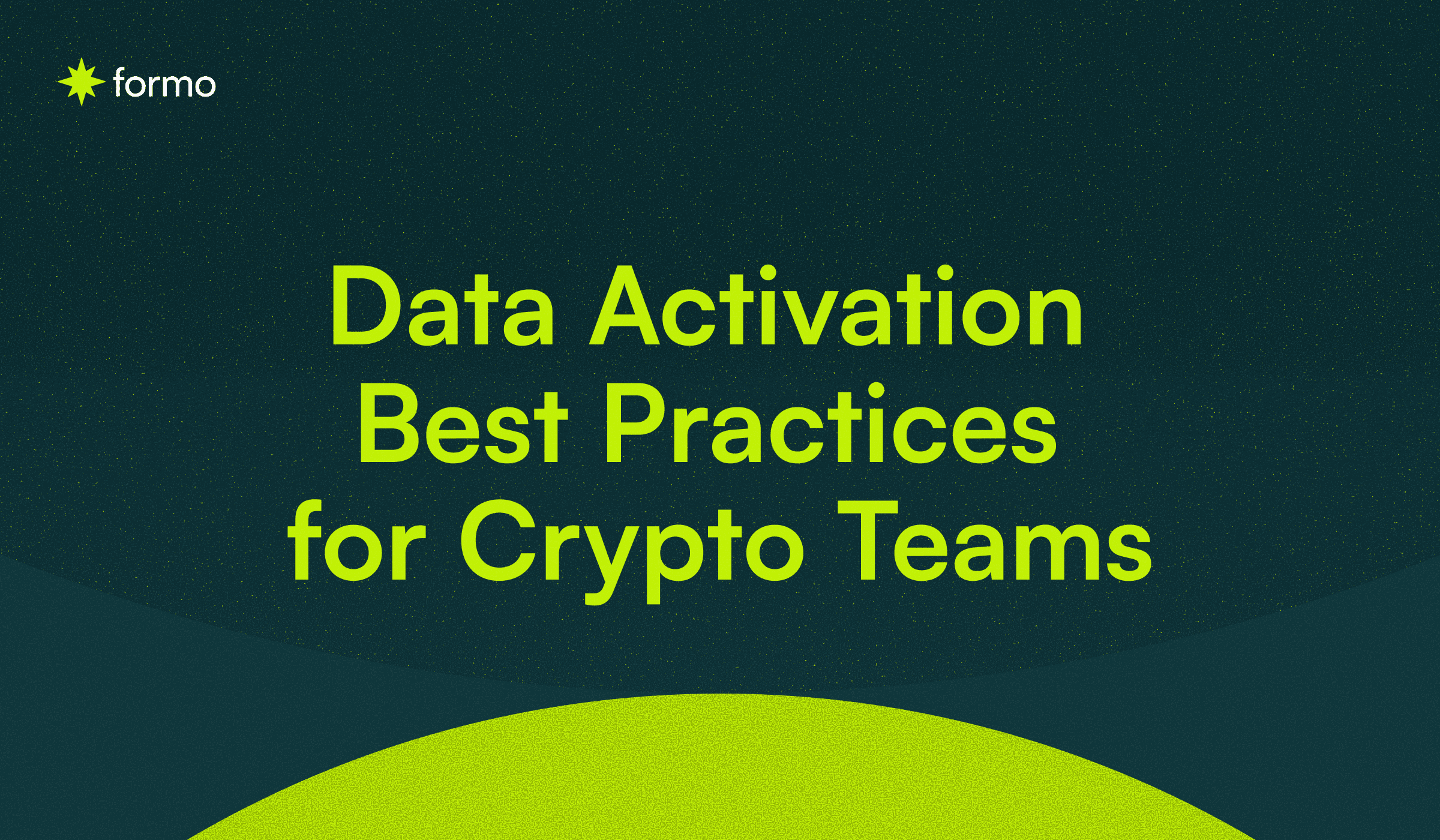Public blockchains provide unparalleled access to user behavior, revealing holdings and activity without requiring direct interaction. In contrast, Web2 data is private and often costly to obtain. Web3 introduces a new approach to targeting: leveraging onchain activity and dApp usage. By indexing transactions between public wallet addresses and smart contract interactions, and linking them to social profiles, Web3 teams can gain powerful insights into their users.
This guide explains Web3 user segmentation and offers actionable steps to implement it effectively.
Key Takeaways
Web3 segmentation combines onchain and social data to personalize user engagement.
Onchain activity and dApp usage are core indicators of user intent and behavior.
Segmenting users by community roles and governance participation provides unique insights.
Behavioral and psychographic data deepen wallet-level analysis.
Tools like Formo, Dune, and Etherscan optimize campaigns with real-time insights.

Web3 user segmentation is a way for data-driven onchain teams to define and target specific groups of onchain users.
What Is Web3 User Segmentation?
Web3 user segmentation is the process of identifying and targeting specific user groups within the Web3 ecosystem. Unlike traditional marketing approaches, which rely heavily on demographics, Web3 segmentation focuses on:
Onchain activity: Transaction history and token balances.
In-App behaviour: Frequency and depth of activity on your app.
Community and social: Social profiles and participation in communities.
Web3 users range from first-time wallet owners to experienced DeFi degens. Effective segmentation takes into account user goals, challenges, and activity patterns. While surveys and interviews provide valuable qualitative insights, onchain data analytics tools like Formo's Web3 product analytics offer a comprehensive view of activity and user engagement for onchain apps.
Targeting these users involves identifying the most relevant segments, while positioning ensures your brand stands out with a compelling value proposition. By understanding user behavior and preferences, teams can deliver personalized experiences, foster engagement, and cultivate long-term loyalty.
Why Does Web3 User Segmentation Matter?
Many Web3 apps struggle with low retention. Using onchain analytics to understand user behavior helps strengthen relationships, drive loyalty, and enhance long-term engagement.
Segmenting Web3 users allows teams to create personalized, targeted marketing strategies that resonate with specific audience groups, boosting engagement and retention.
Align products and services with user preferences.
Address challenges with tailored solutions.
Leverage open onchain data to uncover behavioral insights.
Improve community engagement and loyalty.

Understand your Web3 users to build products and campaigns that boost real engagement and retention.
Web3 segmentation uses onchain data and analytics that provides valuable insights into user behavior.
Types of Web3 User Segmentation Methods
Understanding wallet behavior and interactions allows Web3 teams to optimize campaigns, personalize experiences, and drive growth. Here are five core segmentation methods for Web3 users:
1. Onchain Holdings Segmentation
Segment users based on transaction patterns and token holdings:
Transaction History: Analyze the volume, frequency, and type of onchain transactions. This helps identify power users, casual participants, or dormant users. Example: Active traders on decentralized exchanges such as Uniswap vs. passive holders of tokens.
Token Holdings: Segment users based on the tokens they hold. This could include governance token holders, stablecoin users, or collectors of specific NFTs.
Example: Users who own a governance token or a liquid staking token.
2. Onchain Behavioural Segmentation
Analyze how users interact with specific decentralized apps and protocols to refine product experiences:
Frequency of Use: Daily users, occasional buyers, or passive participants.
App Category: AMMs, DEXs, stablecoins, or fixed yield
Feature Usage: Users who only deposit vs. those leveraging more advanced functions.
Multi-chain Activity: Users who are engaged across specific chains.
Example: Power users who trade on multiple dApps, bridge assets, and transact weekly.
3. Community Segmentation
Social and community engagement provides valuable segmentation insights:
DAO Participation: Active voters vs. passive holders.
NFT Ecosystem Involvement: Collectors, traders, or creators.
Social Signals: Activity on governance forums, Discord, or Farcaster threads.
Example: Wallets with a connected Farcaster or X account.
4. In-App Behavioral Segmentation
Track user behavior both onchain and offchain to understand their motivations and preferences:
Activity-Based Behavior: Identify users based on their actions, such as staking, trading, or voting. Example: Users staking $ETH vs. liquidity providers in DeFi pools.
Engagement Levels: Segment users as active users, newcomers, retained users, or churned.
Retention Stage: Track user lifecycle stages to offer tailored incentives or rewards.
Example: Users who swapped on a DEX but never interacted again.
5. Wallet Labeling Segmentation
Understand users’ motivations, risk tolerance, and interests based on predefined wallet labels:
Risk Tolerance: Group users by their appetite for risk in crypto investments. Example: DeFi yield farmers seeking high APR vs. conservative stablecoin holders.
Interests and Values: Understand whether users are profit-driven, technology-focused, or community-oriented.
Example: Builders vs. Traders vs. Collectors
5 Steps to Segment Web3 Users
Targeting the right audience in Web3 requires more than broad demographics—it’s about understanding onchain behavior, engagement patterns, and user motivations. Follow these five steps to segment and engage your Web3 audience effectively:
Identify Your Target Audience
Start by defining your core user groups based on attributes such as onchain activities (e.g., wallet transactions, dApp usage), community involvement (e.g., DAO memberships), motivations, and pain points.
This step ensures you focus on the most valuable and relevant users that your product is designed for.
Segment Your Web3 Audience
Dive deeper into user data. Utilize wallet metadata, social profiles, and engagement history to create granular user segments. The more precise your segmentation, the more effective your targeting will be.
This helps identify key user groups for better targeting and personalization.
Leverage Targeted Outreach
Engage users where it matters most. Use wallet messaging and other Web3-native channels to reach each segment with timely activation and growth campaigns that convert.
This ensures that your message reaches the right audience at the right time, boosting the effectiveness of your campaigns.
Personalize User Experiences
Provide tailored experiences for each audience segment. Personalize messaging, product recommendations, and engagement strategies to resonate with different user groups.
Personalization strengthens loyalty and improves user retention.
Measure and Optimize
Constantly monitor the performance of your Web3 campaigns.
Use data-driven analytics to refine your strategies, test new approaches, and optimize your messaging. Continuously improving your targeting and segmentation efforts will lead to better results over time.
Web3 Growth and Data Platforms
Due to the complexity of collecting and analyizing onchain data, you need a reliable data platform to perform user segmentation in web3.
Here are some tools to help you monitor key metrics such as conversion, retention, churn, and revenue to optimize dApp performance:
Formo Web3 User Analytics: Wallet intelligence and unified analytics for data-driven onchain teams. Use funnels, wallet profiles, and audience insights to drive growth.
Etherscan: Track onchain transactions and events on a blockchain explorer.
Dune Analytics: Visualize and analyze onchain data.

Formo empowers Web3 teams with Wallet Intelligence and dApp Analytics for deeper community engagement.
Regularly tracking KPIs helps identify opportunities to improve user experience, product functionality, and engagement. Formo empowers Web3 teams with Wallet Intelligence and dApp Analytics, enabling data-driven, targeted campaigns that drive more sustained growth.
Follow us on LinkedIn and Twitter, and join our community to see how Web3 leaders use Formo to drive growth in less time.
Additional reading:
FAQs
1. How is Web3 segmentation different from Web2 segmentation?
Web3 segmentation goes beyond traditional Web2 methods by leveraging onchain data, including wallet activity and token holdings. Unlike traditional Web2 segmentation, which relies on demographics or cookies, Web3 segmentation allows for more accurate, behavior-driven targeting based on real, verifiable activity onchain.
2. Can I segment users without connecting their wallets to my dApp?
Yes. Blockchain data is public by design, so you can analyze wallet behaviors without users logging in or connecting their wallets. Wallet intelligence tools like Formo allow CSV imports of wallet addresses to turn it into rich, actionable user personas.
3. What are some privacy concerns with Web3 user segmentation?
Although wallet addresses are pseudonymous, combining onchain data with offchain identifiers (e.g., social profiles or email addresses) can raise privacy issues. Always prioritize ethical data practices, transparency, and user consent when collecting and analyzing data.
4. How often should I re-segment my Web3 user base?
Web3 user behavior evolves rapidly. Re-segmentation should occur regularly—typically monthly—or after major product updates or marketing campaigns. This ensures your segmentation reflects current behavior patterns and optimizes engagement strategies.
Formo's data platform handles this automatically to keep data fresh.
5. Which metrics are most useful for measuring segmentation effectiveness?
Key performance indicators include conversion rates, user retention, reactivation rates, airdrop participation, and average wallet revenue (RPW). Monitoring these metrics helps assess the success of your segmentation strategy and informs data-driven optimization.




